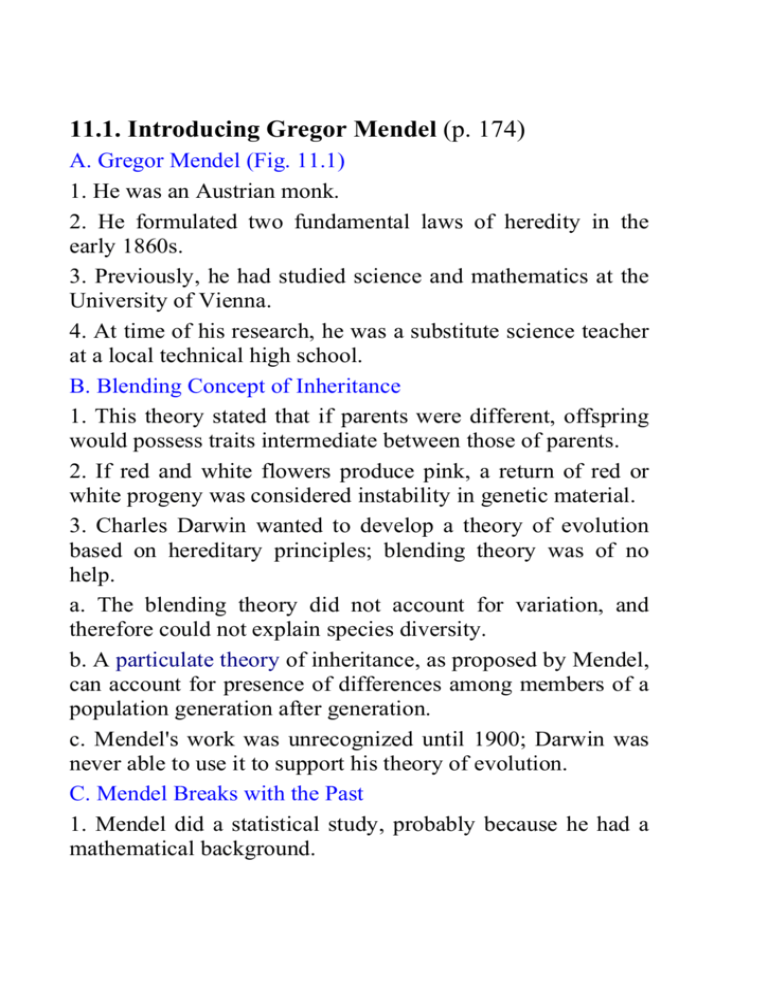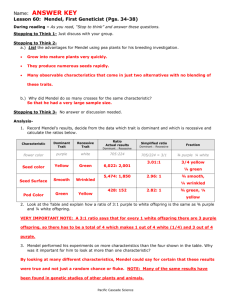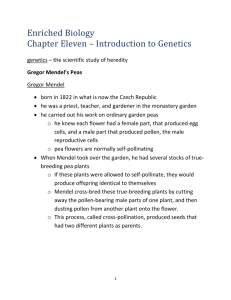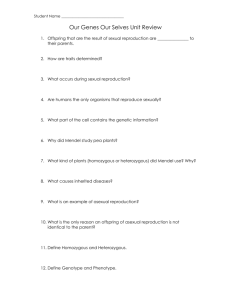11.1. Introducing Gregor Mendel (p. 174)
advertisement

11.1. Introducing Gregor Mendel (p. 174) A. Gregor Mendel (Fig. 11.1) 1. He was an Austrian monk. 2. He formulated two fundamental laws of heredity in the early 1860s. 3. Previously, he had studied science and mathematics at the University of Vienna. 4. At time of his research, he was a substitute science teacher at a local technical high school. B. Blending Concept of Inheritance 1. This theory stated that if parents were different, offspring would possess traits intermediate between those of parents. 2. If red and white flowers produce pink, a return of red or white progeny was considered instability in genetic material. 3. Charles Darwin wanted to develop a theory of evolution based on hereditary principles; blending theory was of no help. a. The blending theory did not account for variation, and therefore could not explain species diversity. b. A particulate theory of inheritance, as proposed by Mendel, can account for presence of differences among members of a population generation after generation. c. Mendel's work was unrecognized until 1900; Darwin was never able to use it to support his theory of evolution. C. Mendel Breaks with the Past 1. Mendel did a statistical study, probably because he had a mathematical background. 2. He prepared his experiments carefully; he conducted preliminary studies. a. He chose to work with garden pea, because peas were easy to cultivate, had a short generation time, and could be cross-pollinated. (Fig. 11.2a) b. From many varieties, Mendel chose 22 true-breeding varieties for his experiments. c. True-breeding varieties had all offspring like the parents and like each other. d. Mendel studied simple traits (e.g., seed shape and color, flower color, etc.). (Fig. 11.2b) 3. Mendel followed inheritance of individual traits; he kept careful records of numbers. 4. He used his understanding of mathematical principles of probability to interpret results. 11.2. Mendel Did a Monohybrid Cross (p. 176) A. Cross-pollination monohybrid crosses. (Fig. 11.3) 1. A hybrid is the product of parent organisms that are truebreeding for distinctly different forms of a single trait. 2. A monohybrid cross is between two parent organisms true-breeding for distinct forms of a single trait. 3. Mendel tracked each trait through two generations. (Fig. 11.3) a. P generation is the parental generation in a breeding experiment. b. F1 generation is the first-generation offspring in a breeding experiment. c. F2 generation is the second-generation offspring in a breeding experiment. B. Mendel's Results 1. Contrary to those predicted by a blending theory of inheritance. 2. He found that the F1 plants resembled only one of the parents. (Fig. 11.3) 3. Characteristic of other parent reappeared in about 1/4 of F2 plants; 3/4 of offspring resembled the F1 plants. (Fig. 11.3 4. Mendel saw that these 3:1 results were possible if a. F1 hybrids contained two factors for each trait, one dominant and one recessive; b. factors separated when gametes were formed; a gamete carried one copy of each factor; c. random fusion of all possible gametes occurred upon fertilization. 5. Results of his experiments led Mendel to develop his first law of inheritance: a. Mendel's law of segregation: Organism contains two factors for each trait; factors segregate in formation of gametes; each gamete contains one factor for each trait. b. Mendel's law of segregation is consistent with a particulate theory of inheritance because many individual factors are passed on from generation to generation. c. Recombination of factors explains variations and why offspring differ from their parents. C. Modern Genetics Has an Explanation 1. Each trait in a pea plant is controlled by two alleles, alternative forms of a gene that occur at the same gene locus on homologous chromosomes. a. Dominant allele masks or hides expression of a recessive allele; it is represented by an uppercase letter. (e.g., T in Fig. 11.4) b. Recessive allele is an allele that exerts its effect only in the homozygous state; its expression is masked by a dominant allele; it is represented by a lowercase letter. (e.g., t in Fig. 11.4) 2. Gene locus is specific location of a particular gene on homologous chromosomes. (Fig. 11.4) 3. In Mendel's cross, the parents were true-breeding; each parent had two identical alleles for a trait--they were homozygous, indicating they possess two identical alleles for a trait. a. Homozygous dominant genotypes possess two dominant alleles for a trait. b. Homozygous recessive genotypes possess two recessive alleles for a trait. 4. After cross-pollination, all individuals of the F1 generation had one of each type of allele. a. Heterozygous genotypes possess one of each allele for a particular trait. b. The allele not expressed in a heterozygote is a recessive allele. 5. Two organisms with different allele combinations can have same outward appearance (e.g., TT and Tt pea plants are both tall; therefore, it is necessary to distinguish between alleles and appearance of organism). (Fig. 11.3) a. Genotype refers to the alleles an individual receives at fertilization. b. Phenotype refers to the physical appearance of the individual. D. Doing Monohybrid Genetics Problems 1. First determine which characteristic is dominant; then code the alleles involved. 2. Determine genotype and gametes for both parents; an individual has two alleles for each trait; each gamete has only one allele for each trait. 3. Each gamete has a 50% chance of having either allele. E. Figuring the Probable Results 1. Probability is the likely outcome a given event will occur from random chance. a. With each coin flip there is a 50% chance of heads and 50% chance of tails. b. Chance of inheriting one of two alleles from a parent is also 50%. 2. Multiplicative law of probability-states that the chance of two or more independent events occurring together is the product of the probability of the events occurring separately. a. Chance of inheriting a specific allele from one parent and a specific allele from another is 1/2 x 1/2 or 1/4. b. Possible combinations for the alleles Ee of heterozygous parents are the following: EE = 1/2 × 1/2 = 1/4 eE = 1/2 × 1/2 = 1/4 Ee = 1/2 × 1/2 = 1/4 ee = 1/2 × 1/2 = 1/4 3. Additive law of probability calculates probability of an event that occurs in two or more independent ways; it is sum of individual probabilities of each way an event can occur; in the above example where unattached earlobes are dominant (EE, Ee, and eE), chance for unattached earlobes is 1/4 + 1/4 + 1/4 = 3/4. F. Punnett Square Figures for You 1. Provides a simple method to calculate probable results of a genetic cross. (Fig. 11.5) 2. In a Punnett square, all possible types of sperm alleles are lined up vertically, all possible egg alleles are lined up horizontally; every possible combination is placed in squares. (Fig. 11.5) 3. The larger the sample size examined, the more likely the outcome will reflect predicted ratios; a large number of offspring must be counted to observe the expected results; only in that way can all possible genetic types of sperm fertilize all possible types of eggs. 4. We cannot testcross humans in order to count many offspring; in humans, the phenotypic ratio is used to estimate the probability of any child having a particular characteristic. 5. Punnett square uses laws of probability; does not dictate what the next child will inherit. 6. "Chance has no memory": if two heterozygous parents have first child with attached earlobes (likely in 1/4th of children), second child born still has 1/4 chance of having attached earlobes. G. Mendel Did a Testcross (Fig. 11.6 ) 1. Mendel performed testcrosses by crossing his F1 plants with homozygous recessive plants. 2. Results indicated the recessive factor was present in the F1 plants; they were heterozygous. 3. A testcross is between an individual with dominant phenotype and individual with recessive phenotype to see if the individual with dominant phenotype is homozygous or heterozygous. 11.3. Mendel Did a Dihybrid Cross (page 181) A. Dihybrid Crosses. (Fig. 11.7) 1. A dihybrid cross is an experimental cross between two parent organisms that are true-breeding for different forms of two traits; produces offspring heterozygous for both traits. (TTGG x ttgg ) TtGg 2. Mendel observed that the F1 individuals were dominant in both traits B. Plants to Self-Pollinate. 1. Mendel observed four phenotypes among F2 offspring; he deduced second law of heredity. 2. Mendel's law of independent assortment states members of one pair of factors assort independently of members of another pair; all combinations of factors occur in gametes. C. Doing Dihybrid Genetics Problems 1. Laws of probability indicate a 9:3:3:1 phenotypic ratio of F2 offspring resulting in the following: a. 9/16 of the offspring are dominant for both traits; b. 3/16 of the offspring are dominant for one trait and recessive for the other trait; c. 3/16 of the offspring are dominant and recessive opposite of the previous proportions; and d. 1/16 of the offspring are recessive for both traits. 2. Punnett square for dihybrid crosses a. A larger Punnett square is used to calculate probable results of a dihybrid cross. (Fig. 11.8) b. A phenotypic ratio of 9:3:3:1 is expected when heterozygotes for two traits are crossed and simple dominance is present for both genes. c. Meiosis explains these results of independent assortment. D. Dihybrids Can Be Tested Also 1. Dihybrid testcrosses test if individuals showing two dominant characteristics are homozygous for both or for one trait only, or is heterozygous for both. (Fig. 11.9) 2. If an organism heterozygous for two traits is crossed with another recessive for both traits, expected phenotypic ratio is 1:1:1:1. (Fig. 11.9) Q: what are the Significance of Meiosis Significance of Meiosis A. Meiosis produces genetic variation. 1. Without meiosis, chromosome numbers would continually increase. 2. Meiosis ensures daughter cells receive one of each kind of gene; precisely halves the chromosome number. 3. Independent assortment provides 2n possible combinations of chromosomes in daughter cells. 4. In humans with 23 haploid chromosomes, 2n = 223 = 8,388,608 possible combinations. 5. Variation is added by crossing-over; if only one crossover occurs within each bivalent, 423 or 70,368,744,000,000 combinations are possible. 6. Fertilization also contributes to genetic variation; (223)2 = 70,368,744,000,000 possible combinations without crossingover. 7. With fertilization and crossing-over, (423)2 = 4,951,760,200,000,000,000,000,000,000 combinations are possible. B. Advantages of Meiosis 1. Tremendous storehouse of genetic variation provides for adaptations to changing environment. 2. Asexual organisms depend primarily on mutations to generate variation. Q : Using Mendel's monohybrid cross as an example, trace his reasoning to arrive at the law of segregation



![Biology Chapter 3 Study Guide Heredity [12/10/2015]](http://s3.studylib.net/store/data/006638861_1-0d9e410b8030ad1b7ef4ddd4e479e8f1-300x300.png)




